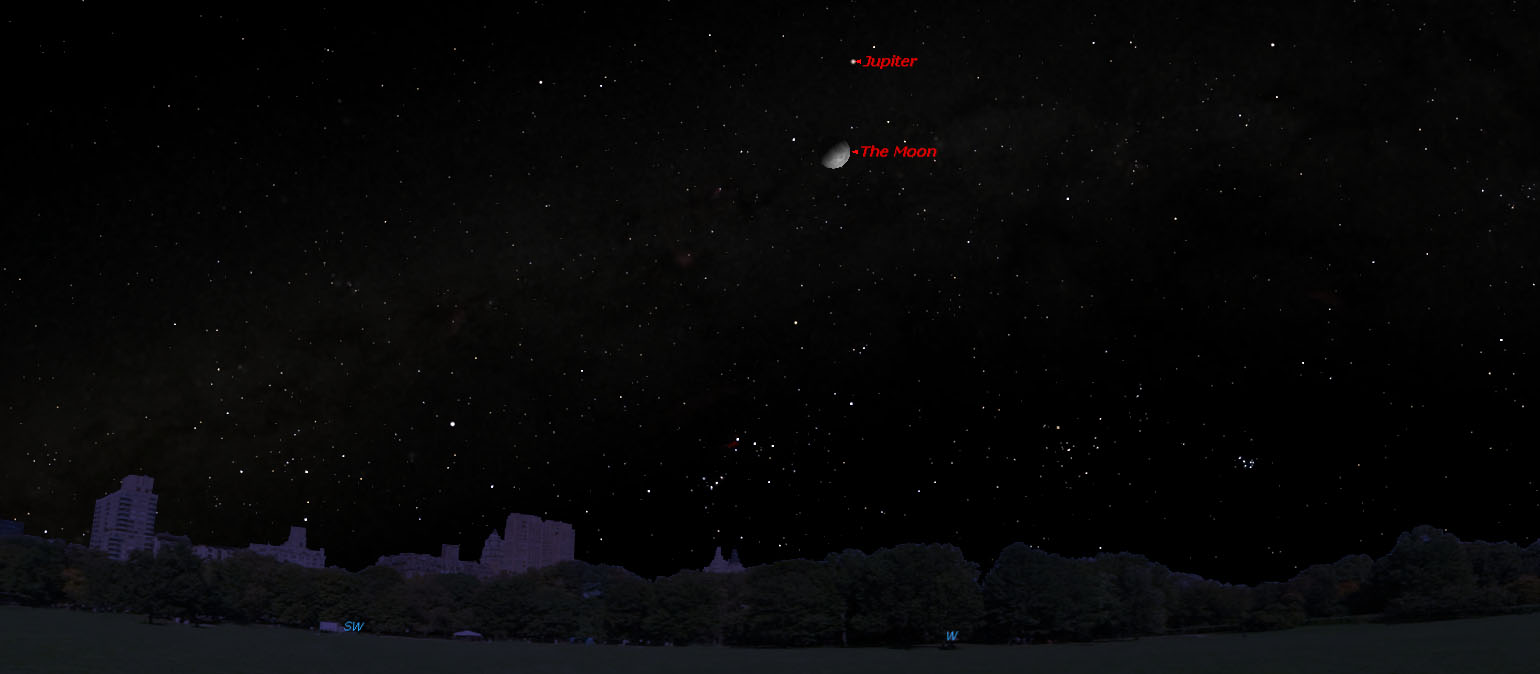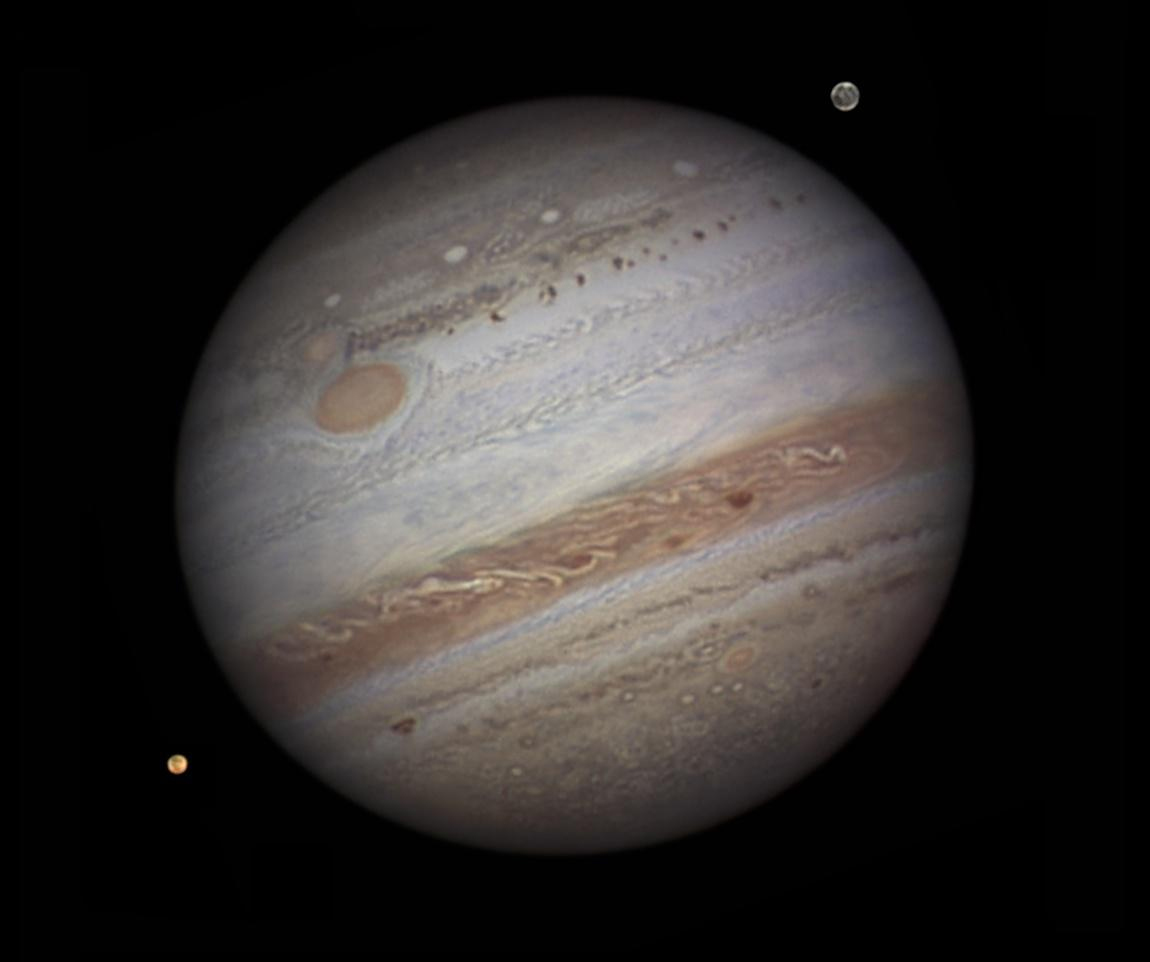
If the skies are clear where you live on Sunday night (March 9), you'll be able to see a waxing gibbous moon shining high in the southern sky, and glowing brightly well above it will be the largest planet in our solar system: Jupiter.
While the moon and Jupiter won't be particularly close to each other, they still will attract some attention thanks to the fact they are the two brightest objects in our current evening sky. The two objects will be separated by about 7 degrees in the night sky (your closed fist held out at arm's length covers 10 degrees of the sky). The proximity of the moon and Jupiter to each other is, of course, merely a matter of perspective.
While the moon, which will be 64-percent illuminated Sunday, will be 247,000 miles (398,000 km) from Earth, Jupiter is nearly 1,800 times more distant, at 444 million miles away (714 million km). [Related: What to See in March's Night Sky]
Jupiter remains the prime night sky target through most of these windy March nights, though it is fading from its great brilliance of December and January. Jupiter becomes visible soon after sunset almost straight overhead for skywatchers at mid-northern latitudes.
As twilight fades and the stars come out around it, we find that it’s shining between the legs of the constellation Gemini; seemingly the brightest "star" in the sky, non-twinkling and shining with a steady silvery light. In the coming weeks you can watch Jupiter edging eastward with respect to surrounding stars.
Meanwhile, Gemini swings westward and rotates into an upright position to set feet first.
Jupiter currently sets by 4 a.m. local daylight time (remember that daylight saving time goes back into effect for most of the country on Sunday; set your clocks ahead one hour).
Get the Space.com Newsletter
Breaking space news, the latest updates on rocket launches, skywatching events and more!
We still have all evening to study Jupiter in a telescope before it gets low and its image too shaky. A 4-inch telescope magnifying at 100-power should provide you with a view of Jupiter’'s cloud bands; with a larger instrument, such as a 10-inch scope at 250-power, you should be able to see fine detail in the clouds as well as get a good look at Jupiter’s Great Red Spot.
And even a pair of steadily held binoculars will show you some or all four of Jupiter's four big moons as they race around the planet that is their master. Jupiter will have its greatest phase angle on April 1 when good telescopes can show a shadowed strip only 0.9 percent of Jupiter's diameter width along its eastern edge. So for the next several weeks it will be a good time to see its shadow cast farthest to its eastern side making it easier to see eclipses of Jupiter’s moons by the planet.

On Sunday evening, all four moons will be visible; a pair flanking Jupiter on both sides. On one side will be Callisto and Europa while on the other side you’ll find Io and Ganymede.
Take special note of Europa as it approaches Jupiter until it finally transits (passes in front of Jupiter) at 3:43 a.m. EDT (0743 GMT) Monday morning. By then, Jupiter will be very near to the western horizon along the Atlantic coast making viewing of this event quite difficult. Farther west though, Jupiter will be higher and Europa's entry onto Jupiter's disk somewhat easier to see.
Editor's note: If you snap an amazing photo of Jupiter and the moon, or any other night sky view, that you'd like to share for a possible story or image gallery, please send images, comments and details on equipment used to managing editor Tariq Malik at spacephotos@space.com.
Joe Rao serves as an instructor and guest lecturer at New York's Hayden Planetarium. He writes about astronomy for Natural History magazine, the Farmer's Almanac and other publications, and he is also an on-camera meteorologist for News 12 Westchester, N.Y.Follow Space.com on Twitter @Spacedotcom. We're also on Facebook & Google+. Original article on Space.com.
Join our Space Forums to keep talking space on the latest missions, night sky and more! And if you have a news tip, correction or comment, let us know at: community@space.com.

Joe Rao is Space.com's skywatching columnist, as well as a veteran meteorologist and eclipse chaser who also serves as an instructor and guest lecturer at New York's Hayden Planetarium. He writes about astronomy for Natural History magazine, Sky & Telescope and other publications. Joe is an 8-time Emmy-nominated meteorologist who served the Putnam Valley region of New York for over 21 years. You can find him on Twitter and YouTube tracking lunar and solar eclipses, meteor showers and more. To find out Joe's latest project, visit him on Twitter.









